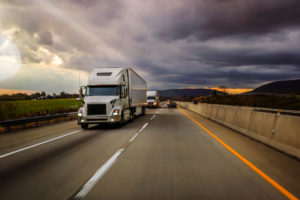By VB Staff,
Trucking is the lifeblood of the American economy, an industry worth almost $875 billion a year in the U.S. alone. That’s about 4% of the U.S. economy. Over the last few years, the supply chain crisis has impacted everyone, with essentials like construction materials, diapers and milk suddenly becoming scarce in stores.
There are many reasons for the supply chain crisis of the last three years, but a critical cause of bare store shelves is that trucking faces an accelerating set of challenges. The trucking industry faces a significant labor shortage — 80,000 drivers short, in fact, which is expected to grow to a shortage of 160,000 drivers by 2030. Companies are also facing recruitment and retention problems, with some estimates suggesting that fleets today are struggling with 100% turnover. But the technology to ease the crisis is already on the road.
“Autonomy and automation are going to be what solve the challenges around filling those long-haul jobs,” says Don Burnette, co-founder and CEO at Kodiak Robotics. “And the current supply chain crisis has put a spotlight on how self-driving trucking technology like the Kodiak Driver has the potential to help make the transportation infrastructure more efficient, and also more resilient.”
Kodiak has already announced partnerships with leading carriers and shippers including IKEA, Werner Enterprises, U.S. Xpress, 10 Roads Express and CEVA Logistics. With these partners Kodiak is moving goods across Dallas, and to Oklahoma, Florida and Atlanta.
How automation is filling the gaps in the truck industry
From reliability to job creation, safety and sustainability, automation will have an enormous positive impact across the supply chain, Burnette says. Here’s a look at what automated fleets can do.
Safety
More than 4,000 Americans died in accidents involving commercial trucks in 2018. Estimates suggest that more than 90% of those accidents were due to human error.
“Safety is mission-critical,” Burnette says. “Whether we’re running a simulation, testing our hardware or software, or putting our trucks on the road, we hold ourselves and each other to the highest safety standards in trucking, self-driving or otherwise. We optimize 100% for safety.”
An automated driver will never text and drive, drive drunk, or get distracted or drowsy. And because self-driving trucks are more predictable, staying largely in the right lane and maintaining a steady speed, other motorists on the road are going to find that they’re more comfortable around self-driving trucks than they would be around traditional trucks, or even other drivers.
That steady, reliable speed and trajectory can also reduce traffic. Autonomous trucks can avoid busy highways at busy times, drive at night as effectively as they do during the day and avoid busy city centers during rush hour. That dramatically reduces congestion and improves traffic.
Efficiency
The dividends for the efficiency of automated trucks, driving nearly 24/7, is tremendous, Burnette says.
“Our trucks will be able to deliver a load across the country in two days, whereas today it takes four,” he explains. “Think about how that affects the shipper. Think about how that affects inventory. You can start to compete with air freight in that sense at a significantly lower cost. This will create cheaper expedited freight than we have today, and those benefits are going to trickle across the supply chain, across the ecosystem.”
And because these trucks also optimize for fuel consumption, they’re significantly more fuel efficient than human-driven ones — even when operating the traditional diesel trucks in use today. A recent study from UCSD estimates there’s roughly a 10% reduction in fuel consumption for self-driving vehicles, which is a huge win for carriers and private fleets.
Utilization
Drivers today are restricted to 11 hours per day of driving, and the average long-haul driver spends about seven hours per day behind the wheel. In contrast, autonomous trucks will be able to drive nearly 24/7. They only have to stop to refuel, to receive standard maintenance and to pick up and drop off trailers. That will double or triple the utilization of these trucks, and immediately have a dramatic effect on alleviating the pressure in the supply chain.
Asset utilization is also an especially meaningful metric for shippers and carriers, as they’re only earning when trucks are moving. Being able to operate nearly 24/7 makes trucks more productive and helps freight move faster.
Job creation
Automating long-haul trucking will create more sustainable local and regional jobs, which are the jobs that most drivers actually want to do. One of the reasons it’s so hard to find drivers today is that it is rare anyone wants to spend days and weeks out on the road away from home and from their families.
“We want to create a hub and spoke model where we drive between highway-adjacent hubs,” Burnette explains. “Humans will transfer the trailers to manually driven tractors, and then use human drivers to drive the first and last mile.”
The technology under the hood
The Kodiak Driver, leveraging a unique sensor fusion system and lightweight mapping solution, is purpose-built for trucks on highways. The Kodiak Robotics team has worked on both autonomous cars and trucks, and know from experience that the specifications and operating domain are just not the same.
“We’ve highly optimized our system for this very narrow application, and that has allowed us to make an incredible amount of progress in less time than our competitors while also spending less money,” Burnette says. “We’ve been able to be much more capital efficient with this approach than a lot of our competitors have.”
Mapping in real time
Kodiak relies on its own proprietary, flexible mapping solution called Sparse Maps. Sparse Maps are easy to build, easy to deploy broadly, and especially suited for the highway environment. Rather than relying on HD maps, Sparse Maps is a much lighter-weight mapping system that puts more focus on perceiving the environment in real time, detecting and reacting to the environment, instead of relying on stored map data which can easily go out of date.
Innovative sensor pod technology
Kodiak’s SensorPod system contains virtually all of the truck’s sensors within a single modular pod, replacing the truck’s stock side-view mirrors. Unlike traditional autonomous sensor systems, Kodiak’s SensorPods come pre-built and pre-calibrated, so they can be changed without any specialized training or equipment — which means they can be serviced quickly out on the open road, as easily as changing a tire.
“That is a game changer when it comes to uptime and efficiency for these fleets,” Burnette says. “That’s the number-one metric that the trucking industry relies on.”
The first completely autonomous trucks will start to roll out in the next couple of years, Burnette predicts. “We are at a point where we’re refining and validating the self-driving vehicle,” he says. “Soon we’ll be able to see all the safety and efficiency benefits we’ve been talking about and currently demonstrate with a safety driver.”

